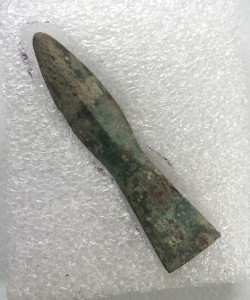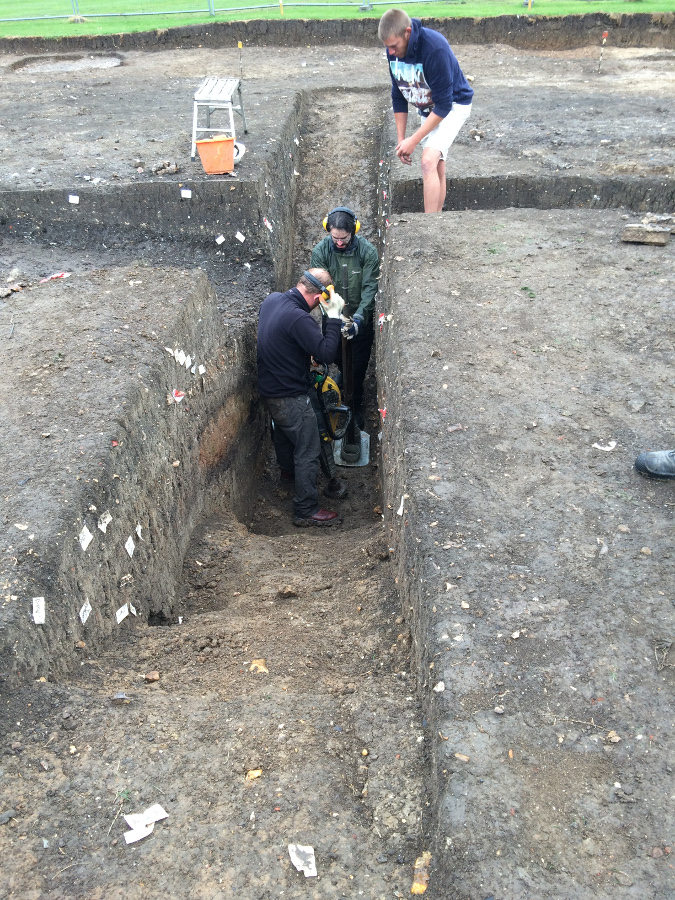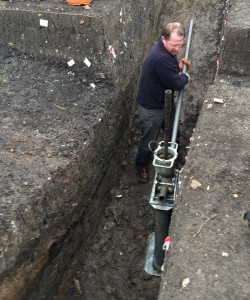I wrote the last blog post on the day of epic weather last week. With rain, wind, hailstones and a general feeling of impending doom we had to call off work for the day quite early, but happily until yesterday had glorious sunshine to make up for it! It’s been unusually mixed this year, but so far progress hasn’t been hampered too much by the weather.

One of our bright and sunny days in the trench at the beginning of our third and penultimate week of digging on Tayne Field.
In fact, absolutely tons of progress has been made since last week, particularly with the Timber Hall trench. We have now managed to confirm that we have the end wall of the hall, which is fantastic news. You can see in this picture below that there is a heap of large flint nodules. This lies outside the external end wall, and the flints provide packing around a raking post to support the roof just like those we excavated on the long walls of the building in 2014.
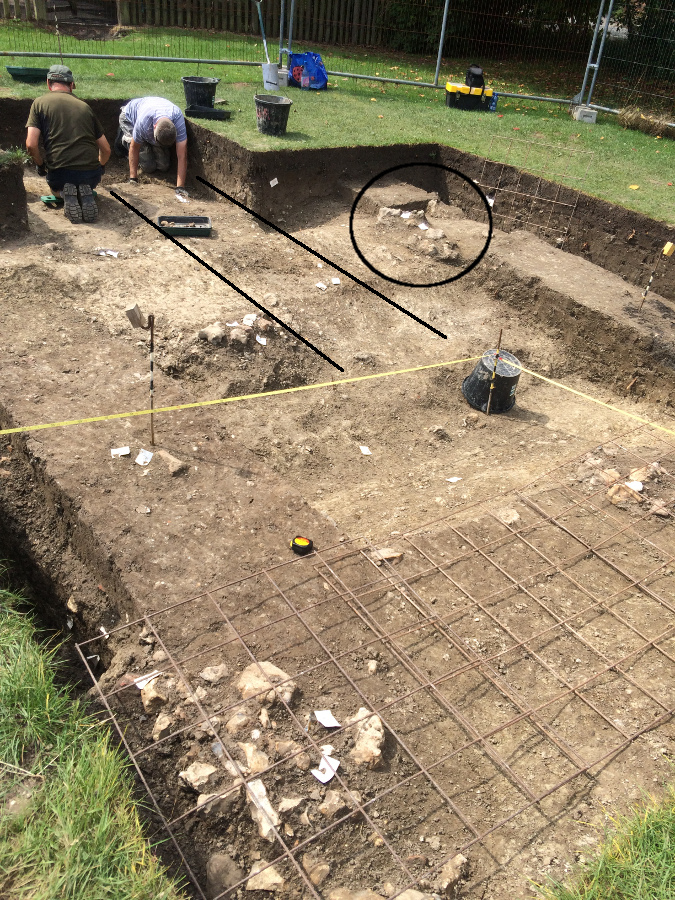
The flint packed raking post on the end wall of the timber hall is circled, and the faint outline of the end wall itself has been marked with two parallel lines.
This hall measures around 23m long, and is the largest hall in our hall complex. You can

Here a slot has been dug through the end wall-trench and half of a large rectangular ‘post ghost’ (the rotted away remains of a post) have been excavated to show the profile, indicated by the circle. Click on the photo to enlarge the image.
perhaps make out in this photo on the right that there are rectangular dark shapes within the wall trench – this are the ‘ghosts’ of rotted out planks that were placed upright in the wall trench, and are quite large compared to those we have excavated in previous seasons.
The midden or ‘blob’ keeps progressing – every time we try to pick up the pace with mattocks we start to get more and more exciting finds and have to go back to careful trowelling! The glass fragment tally is now at 135 and counting, and we are now finding pieces of molten glass, highly suggestive of production.
A particularly exciting piece of glass is this large fragment, clearly some kind of base. The bases of glass vessels are extremely rare and this one is particularly large, perhaps up to 10 cm in diameter.
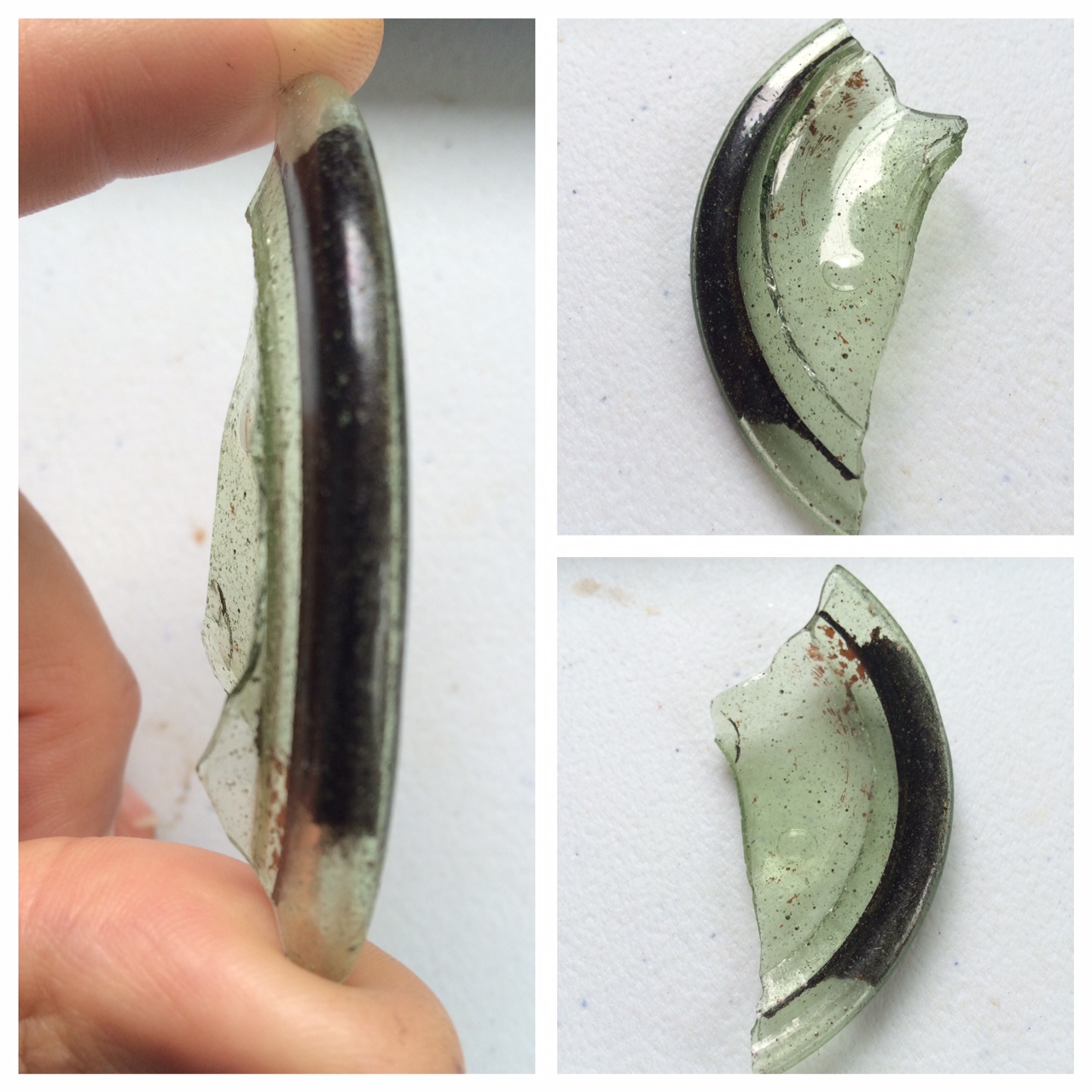
Fragment from the base of a glass vessel, potentially a claw beaker. The dark material is soil from its extensive time in the ground.
A base of similar size was found at the Ango-Saxon settlement at Mucking in Essex, dating to the 5th century, but our fragment comes from layers that are certainly dated much later than this (particularly by the 6th century metalwork from the same layer), so we’re still thinking hard about this unusual glass vessel.
The metal work that has come up from the same layers as much of the glass is of course very interesting indeed! We are tremendously excited to have some lovely complete dress accessories, including some types we haven’t seen here before. Usually dress accessories and jewellery are confined to the cemetery, so it is great to see them in an ‘every day’ setting. This belt strap-end is Frankish in style and is found both in Kent and on the continent, predominently in graves rather than settlements.

The underside of the strap-end. You can see the rivets which would have fastened on to the fabric or leather.
We’ve had a button brooch before, but the one we have recovered this year is from the blob, an Anglo-Saxon midden, whereas last time it was found in a later medieval ditch. This time this jolly little face (if you can make it out!) can give us vital dating evidence for the layer it was found in, and after it is cleaned up it will be obvious that it was gilded.
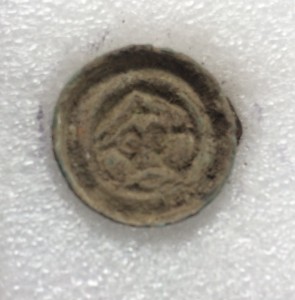
The button brooch, only about 1.5cm in diameter. You can see a stylised face, and perhaps a moustache too!
One of the most exciting finds for lovers of ‘bling’, however, is this lovely saucer brooch, below. It is made of copper alloy and is gilded, with a weave or interlace pattern around the stone, a garnet set into the centre of the brooch. There is a little bit of corrosion marring the surface but the overall design is very clear. It is a type that has been found nearby, at the Buckland, Dover cemetery and it dates to the mid-6th century AD. Examples are found on both sides of the channel, and it isn’t clear whether these brooches come from Kent or from the continent. We have found small fragments of garnet before, but this is the very first time we have uncovered a dress accessory with the inlaid garnet still intact!
The finds are fab, but this week has seen some really interesting archaeological recovery processes! On the wettest day this week, Tuesday, Simon, our project PhD student studying the environment and landscape of the Lyminge area, and Kevin from Quaternary Scientific (Quest), came to take cores through the midden. Because we aren’t able to dig any further down below the flints, we needed a way to investigate the true depth of the ‘blob’. Some advanced technology was deployed!

Kev explains what he is going to do in the bottom of the blob in order to get a true depth for the hole
Kev used a percussion corer, powered by a piece of machinery similiar to that of a concrete breaker, in order to take columns through the blob and into the natural geology so we could understand the depth of the crater and potential get to grips with its origins. Two types of sample were taken: a window gouge allows us to look at the core itself as it comes up. This is an immediate result, where we can see in field straight away where the stratigraphy changes and when we hit natural geology. Kev and Simon also took continuous cores, which are sleeved so you can’t see the results straight away but they can be opened back in the lab and used for lots of different types of scientific analysis.
We had to abandon digging for the day, as it got so wet, but the coring continued until we had continuous samples through two areas through the midden, which should give us some excellent evidence for both the origins for the crater and for the way in which it was filled up with rubbish and industrial material.
The information gained on the day, however, already gives us one of the answers to the questions we had on our return this year. We wanted to find out whether the pit was dug by hand or whether it formed naturally. The window cores taken through the bottom of the central slot show clearly that it is very much deeper than the edges at the centre point, almost a sudden drop off. This means it is very likely that we have a solution hollow, otherwise known as a sinkhole, which opened up back in prehistory, silting up slowly over time and filling up slowly with flints and the odd piece of prehistoric pottery until the Saxons came on the scene, finding a useful hole for their craft working and other industrial processes.

Jess, Emma and Roger dig through the blob layers, coming down soon on to the craft working waste layers
The blob continues to give up it’s secrets and we hope to get down to the flints before the end of the dig so that we can work out their purpose – are they perhaps related to the flint working surface we excavated on the edge of the blob last year? We hope the last week or so will answer these questions and more!
Don’t forget we have a fantastic open day this Saturday, 22nd August, with site tours from Gabor at 11am, 1pm and 3pm, as well as Saxon re-enactment from the Centingas group, a ‘Little Dig’ and other activities for children to get involved in, and of course you’ll be able to see many of these finds up close!

